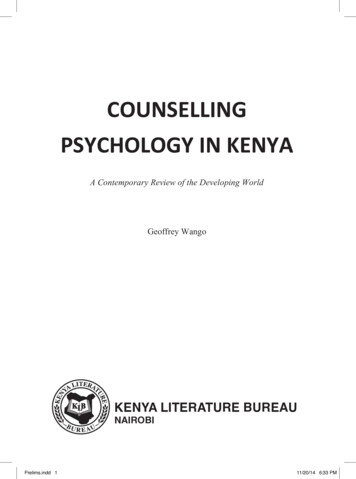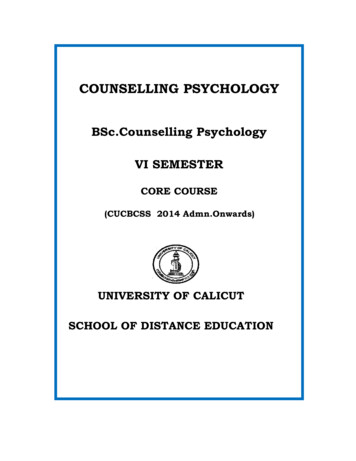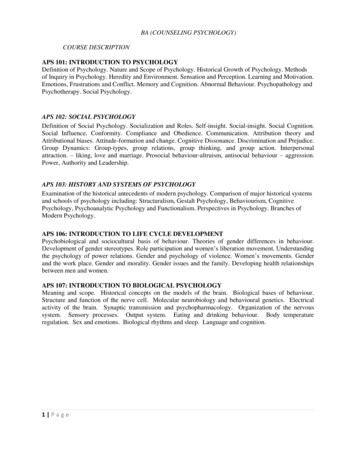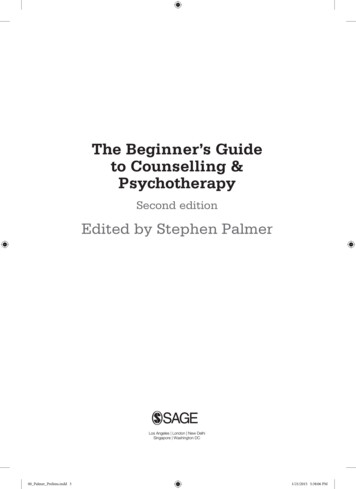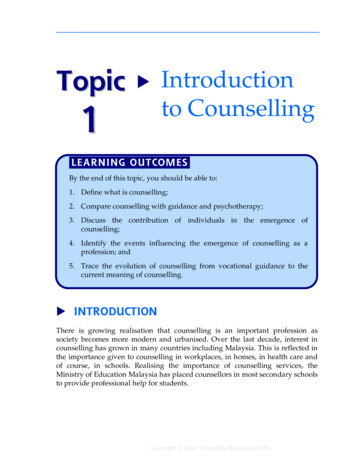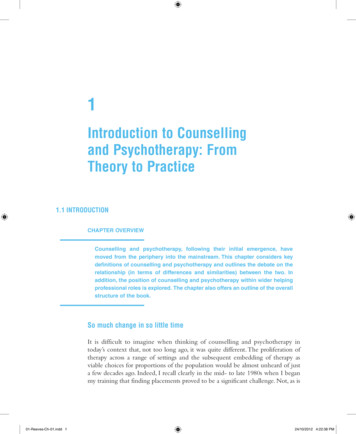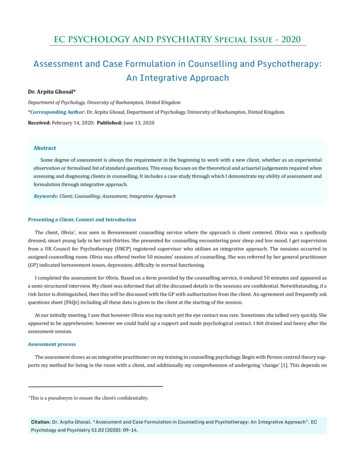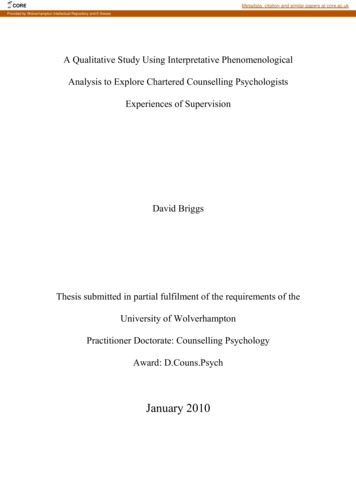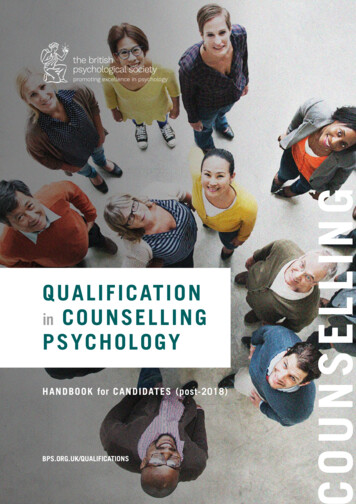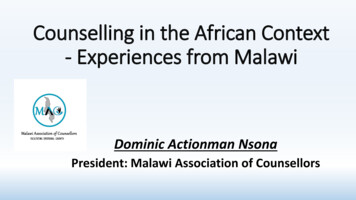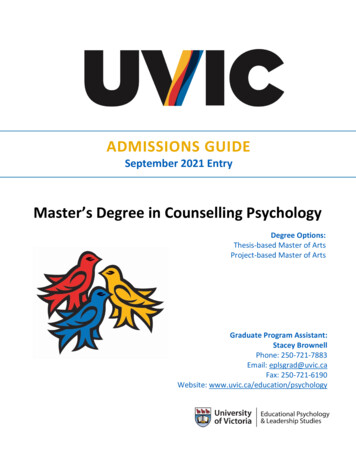
Transcription
ZIMBABWEMINISTRY OF PRIMARY AND SECONDARY EDUCATIONGUIDANCE ANDCOUNSELLING SYLLABUSFORMS 1 - 42015 - 2022Curriculum Development and Technical ServicesP. O. Box MP 133Mount PleasantHarare All rights reserved2015
Guidance and Counselling Syllabus Forms 1 - 4ACKNOWLEDGEMENTSThe Ministry of Primary and Secondary Education wishes to acknowledge the following for their valuedcontribution in the production of this syllabus: The National Guidance and Counselling panel for their professional and technical inputZimbabwe School Examinations Council (ZIMSEC)Representatives from various Guidance and Counselling InstitutionsPublishersNational AIDS Council (NAC)Southern Africa HIV and AIDS Information Dissemination Service (SAfAIDS)LASOF Careers InstituteNhaka Leadership SolutionsUnited Nations Scientific and Cultural Organisation (UNESCO)United Nations Children’s Fund (UNICEF)i
Guidance and Counselling Syllabus Forms 1 - 4CONTENTSACKNOWLEDGEMENTS. iCONTENTS. ii1.0 PREAMBLE. 12.0 PRESENTATION OF THE SYLLABUS. 13.0 AIMS. 24.0 SYLLABUS OBJECTIVES. 25.0 METHODOLOGY AND TIME ALLOCATION . 26.0 TOPICS. 27.0 SCOPE AND SEQUENCE. 38.0 COMPETENCY MATRIX. 6FORM 1. 6FORM 2. 17FORM 3. 26FORM 4. 37ASSESSMENT. 47ii
Guidance and Counselling Syllabus Forms 1 - 41.0 PREAMBLEand values, beliefs, citizenship), child protection andcareer guidance. The thrust of this syllabus is to producea competent, versatile and empowered learner who isable to cope with dynamic life trends.1.1 IntroductionThe Guidance and Counselling learning area is a Form1 to 4 secondary school syllabus comprising six topicsnamely: Unhu/Ubuntu/Vumunhu (Norms and Values),Relationships, Health including Sexuality, HIV and AIDS,Human Growth and Development, Child Protection andCareer Guidance. It prepares learners for an independent productive adulthood and life-long learning. Thissyllabus is designed to equip learners with age-appropriate, culturally relevant, scientifically accurate knowledgeand skills which will produce responsible citizens who willpositively contribute towards nation building.1.4 AssumptionsIt is assumed that learners: 1.2 RationaleGuidance and Counselling is a learning area thatseeks to empower learners with essential life skills thatenable them to survive in a changing socio-economicenvironment comprising the family, local, nationaland global communities. The learning area is verysignificant in the development of Unhu/Ubuntu/Vumunhuattributes as it gives a sense of positive self-image andhigh self-esteem, cherishes diversity and celebratesdifferences among learners. It prepares learners tocope with developmental changes and a variety of riskyfactors such as HIV and AIDS, early marriages, teenagepregnancies, drug and substance abuse.1.5 The Guidance and Counselling syllabus enables learnersto develop skills in: belong to a familyare aware of basic relationshipshave some communication skillsare conscious of general personal hygiene andcommon diseasesare able to identify physical changes at adolescence stageare aware of the diversity of religions and cultureare conscious of types and effects of child abusehave different interests in career choicesCoss Cutting ThemesGender rolesChildren’s rights and responsibilitiesCrisis managementFinancial LiteracySexuality, HIV and AIDSChild ProtectionHeritage Studies (Constitution)Human RightsCollaborationEducation for Sustainable Development2.0 PRESENTATION OF THESYLLABUSSelf-managementManaging diversityCritical thinkingDecision makingProblem solvingCommunicationLearning and ogyThe Guidance and Counselling Syllabus is presented asa single document which covers Forms 1 – 4. All formshave the same topics which are developmental andspiral1.3 Summary of ContentThis syllabus covers the following essential themes inGuidance and Counselling: relationships, health, humangrowth and development, Unhu/Ubuntu/Vumunhu (norms1
Guidance and Counselling Syllabus Forms 1 - 43.0 AIMS5.0 METHODOLOGY AND TIMEALLOCATIONThe syllabus enables learners to:3.13.23.33.43.53.6This syllabus is based upon a learner-centred, handson, multi-cultural, interactive and real life approach. Itpromotes innovation, assertiveness, self-motivation,critical thinking and pragmatic application of concepts toeveryday life.experience personal development anchored onUnhu/Ubuntu/Vumunhu in all facets of lifedevelop the need for relationships and a senseof belonging to the family, community and society through management and celebration ofdiversitydevelop into total and mature individuals,aware of rights and responsibilities, with abilityto respond to real life challenges and socialdynamicsmanage adolescence and live healthy productive livesacquire career planning and development skillsthat contribute to wealth creation and achievement of national development goalsinteract and engage various educational andother support systems related to Guidance andCounselling5.1 MethodologyGames and QuizzesImitation or SimulationVideo and film showsEducational toursDrama, song and poetryCase studyGroup discussionsDiscoveryResearchDebateWork related learningThe above suggested methods are enhanced through theapplication of multi-sensory approaches to teaching andprinciples of individualization, unification, concreteness,tactility (touch), stimulation and self-activity.4.0 SYLLABUS OBJECTIVESBy the end of Form 4 learners should be able to:4.14.24.34.44.54.64.74.85.2describe the significance of Unhu/Ubuntu/Vumunhu (norms and values) to the individual,family and communitydemonstrate the ability to manage intra- personal and inter- personal relationshipsdemonstrate an awareness of children’s rightsand responsibilitiesembrace diversity and overcome stigma anddiscriminationdescribe the processes in human development(personal, social, emotional and physical)apply relevant information related to life skills,sexuality, HIV and AIDS Educationemploy self-assessment tools that guide careerprofiling necessary for identification of careerpathwaysfamiliarize with the world of work through workrelated learning leading to selection of a careerthat matches one’s inclinationT ime AllocationFor adequate coverage of the syllabus a time allocation offour periods of 40 minutes per week should be allocated.It is recommended that learners should go on educationaltours at least twice a year.6.0 TOPICS 2Unhu/Ubuntu/Vumunhu (norms and values), beliefsand citizenshipRelationshipsHealthHuman growth and developmentChild protectionCareer guidance
Child protectionCareer guidanceSUB-TOPIC3Unhu/Ubuntu/VumunhuUnhu /Ubuntu/Vumunhu at home,school and communityNorms values and beliefs inZimbabweUnhu/Ubuntu/Vumunhu in variousroles and contextsGrooming and etiquetteSelf-image and self-esteemFamily Types of familiesTypes of relationshipsCommunication skillsFORM 17.2 TOPIC 2: RELATIONSHIPSTOPIC 2: RELATIONSHIPSSUB-TOPIC7.2 FORM 1Grooming and etiquetteSelf-image and selfesteemReligious andIndigenous beliefsVarious religions inZimbabwe Roles of familymembersAbusive relationshipsPersonal identity andlife skillsFORM 2 FORM 2Grooming and etiquetteSelf-image and self-esteemConcept of respectRespect and tolerance Conflicts and ConflictManagementCommunication inrelationshipsFORM 3 FORM 37.1 TOPIC 1: UNHU/UBUNTU/VUMUNHU (NORMS AND VALUES), BELIEFS AND CITIZENSHIPTOPIC 1: UNHU/UBUNTU/VUMUNHU (NORMS AND VALUES), BELIEFS AND CITIZENSHIPUnhu/Ubuntu/Vumunhu7.17.0 SCOPE AND SEQUENCE7.0 SCOPE AND SEQUENCE Grooming andetiquetteSelf-image and selfesteemCitizenshipPatriotism Challenges to familycohesionManagingrelationshipsConflict managementPeer pressureFORM 4 FORM 47Guidance and Counselling Syllabus Forms 1 - 4
Personal and environmentalhygieneImmunizationSexual and reproductive healthHIV and AIDSDrug and substance abuseHealthy livingFORM 1TOPIC 3: HEALTH Sexual and reproductivehealthHIV and AIDSCommunicable andnon-communicablediseasesDrug and substanceabuseHealthy livingFORM 24Sexuality Puberty and adolescenceSex and sexualityPsycho-social support systemsDisabilityFORM 1 Anatomy andPhysiologySexualityTeenage pregnancyPsycho-social supportsystemsDisabilityFORM 27.4 TOPIC 4: HUMAN GROWTH AND DEVELOPMENTTOPIC 4: HUMAN GROWTH AND DEVELOPMENTSUB-TOPIC7.4Health management7.3TOPIC 3: HEALTHSUB-TOPIC7.3Personal and environmentalhygieneGrooming and etiquetteSexual and reproductivehealthHIV and AIDSCommunicable and noncommunicable diseasesDrug and substance abuseHealthy living Anatomy and PhysiologySexualityTeenage pregnancyPsycho-social supportsystemsDisabilityAdolescence and stressmanagementFORM 3 FORM 3Sexual andreproductive healthand rightsHIV and AIDSStigma anddiscriminationDrug and substanceabuseMental HealthBasic care andsupport for peoplewith disabilitiesHealthy living Anatomy andPhysiologySex and sexualityDisabilityPsycho-social supportTeenage pregnancyFORM 4 FORM 49Guidance and Counselling Syllabus Forms 1 - 4
Concept of Child Rights andResponsibilitiesChild abusePolicies and legislation on ChildRights in ZimbabweDrug and Substance AbuseCareers Study skillsCareer awarenessEnterpriseInterviewsGuidance and Counselling PortfolioIndividual transitional programsFORM 17.6 TOPIC 6: CAREER GUIDANCETOPIC 6: CAREER GUIDANCESUB-TOPIC7.6Child Rights andResponsibilitiesForm 17.5 TOPIC 5: CHILD PROTECTIONTOPIC 5: CHILD PROTECTIONSUB-TOPIC7.5Concept of ChildRights andResponsibilitiesChild AbusePolicies andlegislation on Childrights in SouthernAfrica5 Career explorationStudy skillsInterviewsIndividual transitionalprogramsGuidance andCounselling PortfolioEnterpriseFORM 2 Form 2Concept of Child Rights andResponsibilitiesChild abusePolicies and legislation onChild rights in SouthernAfrica Study skillsEnterpriseIndividual transitionalprogramsGuidance and CounsellingPortfolioInterviewsCareer planningFORM 3 Form 3Concept of ChildRights andResponsibilitiesChild abusePolicies andlegislation on Childrights in the World Study skillsEnterpriseIndividual transitionalprogramsGuidance andCounselling PortfolioCareer planningWork related learningexperienceFORM 4 Form 411Guidance and Counselling Syllabus Forms 1 - 4
(NORMS AND VALUES), BELIEFS AND CITIZENSHIP6outline Unhu/Ubuntu/Vumunhuin various roles and contextsdiscuss the factors affectingUnhu/Ubuntu/Vumunhu Unhu/Ubuntu/Vumunhu invarious roles andcontextsstate the norms, values andbeliefs in the localitydescribeUnhu/Ubuntu/Vumunhu athome, school and communitydefine Unhu/Ubuntu/Vumunhuand related conceptslist characteristics ofUnhu/Ubuntu/Vumunhu Norms, values and beliefsin ZimbabweUnhu /Ubuntu/Vumunhuat home ,school andcommunityConcept ofUnhu/Ubuntu/Vumunhu Factors es in different contextsNorms, values and beliefsUnhu/Ubuntu/Vumunhu athome, school tics ofUnhu/Ubuntu/Vumunhu Involving learners incultural exchange programsDemonstratingUnhu/Ubuntu/Vumunhuroles in different contextsListing norms, values andbeliefsDescribing norms, valuesand beliefsDramatisingUnhu/Ubuntu/Vumunhu athome, school andcommunityDescribingUnhu/Ubuntu/VumunhuAnalysing Unhu/Ubuntu8.1 TOPIC 1: UNHU/UBUNTU/VUMUNHU (NORMS AND VALUES), BELIEFS AND CITIZENSHIPSUB TOPIC: UNHU/UBUNTU/VUMUNHUKEY CONCEPTOBJECTIVES:UNIT CONTENTSUGGESTED LEARNINGLearners should be able toACTIVITIES8.0 COMPETENCY MATRIXFORM 1 1: UNHU/UBUNTU/VUMUNHU8.1 TOPICFORM 18.0 COMPETENCY MATRIX PamphletsResourceperson(s)Case studyReading novelsVideosPamphletsResourceperson(s)Case studyReading novelsVideosPamphletsResourceperson(s)Case studyReading novelsVideosPamphletsResourceperson(s)Case studyReading novelsVideosLEARNINGRESOURCES14Guidance and Counselling Syllabus Forms 1 - 4
Self-image and selfesteem Grooming and Etiquettedefine self-image and selfesteemexplain the importance of selfimage and self-esteemassess self-image and selfesteemdefine grooming and etiquettedistinguish acceptablesituational behavior fromunacceptable behavior Self-image and selfesteemSignificance of self-imageand self-esteemDefinition of-dress code-table manners-Walking style-deportment-situational appropriatecommunication-body posture-eye contactManagement of behavior:-Unacceptablesituational behavior-acceptable behavior Describing self-image andself-esteemDebating on the importanceof self-image and selfesteemParticipating in publicspeakingDemonstrating deportmentDiscussing mannerismsincluding spittingDemonstrating appropriatesituational behaviorsDiscussing behaviorsportrayed in videosDramatising situationalbehaviors ICT toolsBraille materialPamphletsICT dance and Counselling Syllabus Forms 1 - 47
TOPIC 2: RELATIONSHIPSCommunicationskills Types ofRelationships Family typesstate types of communicationillustrate effective communicationidentify different types ofrelationshipsdescribe the different types ofrelationshipslist types of familiesdescribe different types of families8.2 TOPIC 2: RELATIONSHIPSSUB TOPIC: TYPES OF FAMILIESKEY CONCEPTOBJECTIVES:Learners should be able toSUB TOPIC: TYPES OF FAMILIES8.28 Types ofcommunicationBarriers tocommunicationForms ofcommunicationDifferent types ofrelationships such as:-friendships-dating and courtship-marriage(refer toconstitution)Different family typessuch as:Nuclear, extended,Child headed , oneparentUNIT CONTENT Listing the different types ofcommunicationDiscussing effectivecommunicationListing different types ofrelationshipsBrainstorming on differenttypes of relationshipsRole playing different types ofrelationshipsIdentifying different types offamiliesPlaying roles of differentfamily membersStory tellingSUGGESTED LEARNINGACTIVITIES Electronic and printmediaBraille materialSign languagematerialPamphletsBraille materialResource person(s)Case studyReading novelsVideosICT toolsBraille materialVideosLEARNINGRESOURCES15Guidance and Counselling Syllabus Forms 1 - 4
TOPIC 3: HEALTHPersonal andenvironmentalhygiene define personal andenvironmental hygiene and otherrelated termsState the importance of hygienelist waste management lawsdescribe ways of disposing wasteSub TOPIC: HEALTH MANAGEMENTKey Concept TopicObjectivesLearners should be able to:8.3 TOPIC 3: HEALTHSUB TOPIC: HEALTH MANAGEMENT8.3 Definition of keyconcepts related topersonal andenvironmental hygienePersonal hygiene e.g.-bathing-oral care-ear care-eye care-laundry-hand washingMenstrual hygieneenvironmental hygiene-waste disposal e.g.recycling-Water and SanitationHygiene (WASH)Unit Content Describing personal andenvironmental hygieneDemonstrating hand washing,dental care and proper toiletuseDiscussing menstrualhygiene managementDemonstrating waste disposalSuggested learning activities ICT toolsResource person(s)PamphletsResources16Guidance and Counselling Syllabus Forms 1 - 49
HIV and AIDSSexual andreproductivehealth andrights (SRHR)10 define HIV and AIDSdescribe modes oftransmissionidentify ways ofpreventionstate myths andmisconception on HIVand AIDSdeliberate on treatment,care and supportdefine SRHRstate reproductive healthrights andresponsibilitiesoutline sexualreproductive healthchallenges andprevention strategiesdefine immunizationdescribe importance ofimmunizationdispel myths andmisconceptions onimmunizationImmunization ObjectivesLearners should be ableto:Key ConceptTopic HIV and AIDSModes of transmissionWays of preventing HIVtransmissionHIV TestingCommon myths and misconceptionsTreatment, Care and Support forpeople living with HIV (PLHIV)Positive livingStigma and DiscriminationGender and HIVSexual and reproductive health andrights (SRHR)Reproductive health rights andresponsibilitiesSexual healthSexual reproductive healthchallenges-teenage pregnancy-STIs-HIVPrevention strategies-Voluntary Medical Malecircumcision (VMMC)ImmunizationRationale for immunizationMyths and misconceptionsImmunization service providersUnit Content Explaining HIV and AIDSIdentifying modes of transmissionDiscussing ways of preventing HIVtransmissionStating HIV and AIDS myths andmisconceptionsDescribing HIV treatment, care,support and adherenceOutlining positive living includingnutrition for PLHIVDiscussing stigma and discriminationDescribing SRHRIdentifying sexual and reproductivehealth rights and responsibilitiesDiscussing importance of sexualhealthIdentifying SRH challenges andprevention measuresWatching STI and HIV videosDescribing immunizationComposing immunization songs,poemsDramatising immunization myths andmisconceptions/benefits ofimmunizationWatching videos on immunizationSuggested learning activities Age appropriateaudio-visualmaterials e.g.-videos-Picture codes-Pamphlets-Posters-Braille materialResourceperson(s)ICT toolsAge appropriateaudio-visualmaterials e.g.-videos-Picture codes-Pamphlets-Posters-Braille materialResourceperson(s)ICT toolsResourceperson(s)ICT toolsChild health cardChartsPamphletsPicture codesVideoResources18Guidance and Counselling Syllabus Forms 1 - 4
Healthy livingDrug andsubstanceabuse define healthy livingdescribe the importanceof a balanced dietdefine drug andsubstance abuseidentify types of drugsand substancesstate effects of drug andsubstance abusestate ways of preventingdrug and substanceabusedistinguish between drugand substance abuseexplore stigma anddiscrimination on HIVand AIDSDiscuss genderdynamics in HIV Healthy living e.g.-Nutrition-eating habits-weight control-wellness-Balanced diet-Physical fitnessMental healthDrug and substance abuseCauses of drug and substanceabuseTypes and sources of drugs andsubstancesWays of preventing drug andsubstance abuseEffects of drug and substance abuseManagement of drug and substanceabuse-rehabilitation11 Explaining components of healthyliving, nutrition and balanced dietResearching on local balanced dietParticipating in physical fitnessactivitiesDiscussing common mental healthproblemsDefining drug and substance abuseWatching videos and discussingissues depicted in videosResearching on drugs andsubstancesDramatising on drug and substanceabuseDebating on drug and substanceabuseAnalysing gender dynamics in HIV audio-visualmaterials e.g.-videos-Picture codes-Pamphlets-Posters-Braille materialResourceperson(s)ICT toolsResourceperson(s)Age appropriateaudio-visualmaterials-videos-Picture codes-Pamphlets-Posters-Braille materialICT tools18Guidance and Counselling Syllabus Forms 1 - 4
Sex and Sexuality12 Puberty andadolescenceexplain the meaning of sex andsexualitystate the consequences of earlysexual debutpractice ways of delaying sexualdebutdefine puberty and adolescenceidentify physical, emotional andpsychological changesmanage the physical, emotionaland psychological changesOBJECTIVES:Learners should be able toKEY CONCEPTMeaning of termsassociated with sex andsexuality such as- Sex- Sexuality- Sexual debut- Abstinence Consequences of earlysexual debut such as-Teenage pregnancies-Early marriages-STIs Ways of delaying sexdebut-Setting limits on howfar they go in expressing romantic affection-Avoiding sexual stimulating situations Puberty and adolescence Changes associated withpuberty and adolescence- Physical changes- Physiological changes- Emotional changes Ways of managingchanges in puberty andadolescence UNIT CONTENTTOPIC 4: HUMAN GROWTH AND DEVELOPMENTSUB TOPIC: SEXUALITY8.4 Researching on puberty andadolescenceDescribing the physical, emotionaland psychological changesListing the ways of managingchanges associated with pubertyand adolescenceDemonstrating ways of managingchanges in puberty and adolescenceResearching on sex and sexualityExplaining the consequences ofearly sexual debutDiscussing ways of delayingsexual debutResearching on puberty andadolescenceDescribing physical, emotionaland psychological changesDiscussing ways of managingchanges associated with pubertyand adolescenceSUGGESTED LEARNING ACTIVITIES ICT toolsPamphletsResource person(s)Braille materialsSign language materialsTalking bookVideosICT toolsResources person(s)ChartsText booksBraille materialLEARNING RESOURCESGuidance and Counselling Syllabus Forms 1 - 4
DisabilityKey ConceptTopicPsycho-socialsupport systems define disabilityidentify different types and formsof disabilityfind ways of assisting peoplewith disabilitiespromote inclusion of people withdisabilitiesObjectivesLearners should be able to: define psycho-social supportsystems access services for psychosocial support systems DisabilityDifferent types andforms of disabilitySupport Systems forpeople with disabilityPsycho-social supportsystemsService providers thatoffer psycho-socialsupport systemsUnit Content13 Describing psycho-social supportsystemsListing service providers thatoffer psycho-social supportsystemsIdentifying the service providersthat offer psycho-social supportservicesTraining in peer educationClassifying disabilitiesExplaining different forms ofdisabilitySelecting ways of assistingpeople with disability dependingon the nature of the disabilityIdentifying learners withdisabilities in communities whoare deprived of educationSensitizing communities ondisabilitiesAppreciating inclusion of peoplewith disabilities in schools andcommunitiesSuggested learning activities ICT ToolsPamphletsResource person(s)Child-led ProtectionCommitteesBraille materialSign languagedictionaryICT ToolsResource person(s)Text booksBraille materialResources20Guidance and Counselling Syllabus Forms 1 - 4
TOPIC 5: CHILD PROTECTION14 Drug andsubstance abuse Policies andLegislation onChild Rights inZimbabweChild abusedefine drug and substanceabuselist types of drugs andsubstancesidentify sources of drugs andsubstancesstate the effects of drug andsubstancesdefine policy and legislationidentify policies and legislationdefine child abusestate types and forms of childabuseidentify common learnerincidencesdescribe prevention andmanagement of child abuse8.5 TOPIC 5: CHILD PROTECTIONSUB TOPIC: RIGHTS AND RESPONSIBILITIESKEY CONCEPTOBJECTIVES:Learners should be able toChild rights and define child rights andresponsibilitiesresponsibilities state examples of child rightsand responsibilitiesSUB TOPIC: RIGHTS AND RESPONSIBILITIES8.5 drug and substanceabusetypes of drugs andsubstancessources of drugs andsubstanceseffects of drugs andsubstancesPolicies and legislation Policy and legislationDefinitionTypes and forms of childabuseCommon learnerincidences such as sexparties, satanism,pornography, teenagepregnancies,examination stress,suicideReporting structuressuch as Child-ledProtection CommitteesReferral systemsDefinitionExamples of child rightsand responsibilities UNIT CONTENT Explaining drug and substanceabuseDifferentiating between drugsand substancesAnalysing the effects of drugsand substancesIdentifying commonly abuseddrugs and substancesStating policies and legislationExplaining policies andlegislationExplaining child abuseNaming types and forms of childabuseDiscussing incidencesIdentifying reporting structuresOffering psycho-social sSUGGESTED LEARNINGACTIVITIES Listing child rights andresponsibilities Describe child rights andresponsibilities 21ZimbabweanConstitution 2013Education Act 1996Resource person(s)Resource person(s)PicturesPamphletsFlyersICT toolsAudio and visual tapesICT toolsText booksZimbabweanConstitution 2013Child rights policiesSecretary’s CircularMinute No 5 of 2000Director Circular No 27of 2008ICT toolsNewspapersResource person(s) the victim friendly unitVideosAudio tapesBraille materialmaterialsLEARNING RESOURCESGuidance and Counselling Syllabus Forms 1 - 4
TOPIC 6: CAREER GUIDANCE15 InterviewsGuidance andcounsellingportfolio Career awarenessEnterprise Study skillsidentify the importance ofportfolios in assessmentprogramsprepare for an interviewdescribe types of interviewsname different incomegenerating projectsdraft proposalsidentify niche in businessdevelop career awarenessidentify a career pathway thatmatches the learner’sorientationexplain appropriate study skillsdesign a study timetable8.6 TOPIC 6: CAREER GUIDANCESUB TOPIC: CAREERSKEY CONCEPTOBJECTIVES; The learnershould be able to;SUB TOPIC: CAREERS8.6 Importance of portfoliosin assessment programsRelevance of profiling incareer choicesPreparing for aninterviewTypes of interviewsIncome generatingprojectsProject proposalsNiche in businessCareer awareness skillsSelect career pathwayand option:- employment- self-employment- tertiary educationappropriate study habitsStudy processesStudy timetableUNIT CONTENT Discussing the importance ofportfolios in assessmentsResearching on relevance ofprofiling in career choicesRole playing and dramatizingDiscussing types of interviewsListing income generatingprojectsWriting proposalsDetermining product or serviceto be offeredDetermining marketExplaining career awarenessskillsExploring Learner passions andinterestsExploring exit optionsAttending career daysDeveloping a job searchstrategy (for employment option)Designing a business andmarketing plan (for selfemployment option)Formulating a tertiary educationplanDiscussing the importance ofnote making and reading notesSUGGESTED ACTIVITIES ICT toolsResource person(s)ChartsICT toolsChartsResource person(s)Resource person(s)ChartsICT toolsICT toolsResource person(s)Reports on labourmarket trendsStudy packICT tools23LEARNING RESOURCESGuidance and Counselling Syllabus Forms 1 - 4
Individualtransitionalprograms name vocational centresdescribe the importance ofvocational centres in careerchoicesdescribe the relevance ofprofiling in career choices Vocational centresImportance of vocationalcentres Identifying vocational centresDiscussing the importance ofvocational centresCase studying PamphletsResource person(s)Case studyVideos24Guidance and Counselling Syllabus Forms 1 - 416
FORM 2TOPIC 1: UNHU/UBUNTU/VUMUNHU (VALUES), BELIEFS AND CITIZENSHIP17KEY CONCEPTReligious andindigenous beliefsSelf-image and selfesteemGrooming andEtiquetteexplain how one can build positive selfimage and self-esteemoutline reasons for negative self-imageand self-esteemdescribe importance of grooming andetiquettedistinguish acceptable situationalbehavior from unacceptable behaviorOBJECTIVES: Learnersdefineshouldreligion beandableindigenousbeliefsto explain religion and indigenous beliefs compare religious and indigenousbeliefs Positive self-image andself-esteemReasons for negative selfimage and self-esteemAcceptable situationalbehaviorUnacceptable situationalbehaviorManagement of behaviorUNIT CONTENT Religion and indigenousbeliefs types of religions andindigenous beliefs myths and misconceptions Modern versus indigenouspractices Researching on ways ofbuilding positive self-imageand self-esteemDiscussing reasons fornegative self-image andself-esteemStating ways to carryoneselfDiscussing mannerismsDemonstrating appropriatesituational behaviorsDiscussing behaviorsportrayed in videosDramatizing situationalbehaviorsSUGGESTED LEARNING ACTIVITIESExplaining religion andindigenous beliefs Comparing religion andindigenous beliefs Discussing myths and misconceptions Deliberating on religionsand indigenous beliefs Singing and dancing Debating on indigenousand modern practices 8.7 TOPIC 1: UNHU/UBUNTU/VUMUNHU (VALUES), BELIEFS AND CITIZENSHIPSUB TOPIC: UNHU/UBUNTU/VUMUNHUKEY CONCEPTOBJECTIVES:UNIT CONTENTSUGGESTED LEARNINGLearners should be able toACTIVITIESSUB TOPIC: UNHU/UBUNTU/VUMUNHU8.7FORM 2COMPETENCY MATRIX25ICT toolsResourceperson(s)PamphletsVideosBraille materialSign languagematerialICT toolsResourceperson(s)PamphletsVideosBraille materialSign languagematerialLEARNING RESOURCESResource Person(s) Pictures Charts LEARNINGRESOURCESGuidance and Counselling Syllabus Forms 1 - 4
TOPIC 2: RELATIONSHIPS18Personal identityand life skillsAbusiverelationshipsR
Guidance and Counselling Syllabus Forms 1 - 4 1 1.0 PREAMBLE 1.1 Introduction The Guidance and Counselling learning area is a Form 1 to 4 secondary school syllabus comprising six topics namely: Unhu/Ubuntu/Vumunhu (Norms and Values), Relationships, Health including Sexuality, HIV and
